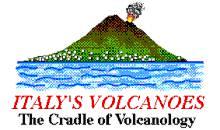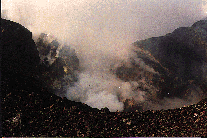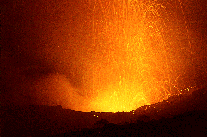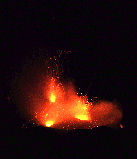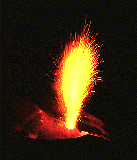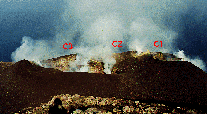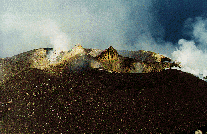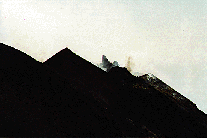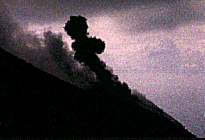| Stromboli
home page |
||
| Geography | Geological Evolution | Eruptive history |
| Volcanic Hazards | References | Web sites |
Activity from 1985
to 1995:
A decade in the history of Stromboli
![]()
After more than 2.5 years, I finally returned to Stromboli in mid-March 1994. The volcano was in a "normal" state of activity and still the effects of the October 1993 explosions were very evident. The upper part of the 1985-86 lava flows and all of the 1993 flows below the NE end of Crater 1 were buried under a thick cover of explosion debris - large, reddish blocks, some several meters in diameter. The eruptive vents were at the floors of deep chasms inside the craters and barely visible from the summit. On 9 March, visual observation was rendered completely impossible by clouds moving in when I reached the summit, and the rare moments when there were breaks in the clouds only permitted the view of dense vapor and gas clouds. The next day I was back on the mountain, and there was good visibility this time. The activity was relatively low, and I decided to descend to the craters another time. I stayed about 2 hours on the rim of Crater 3, most of this after dusk when the activity of the faithful vent 1 became too fascinating to leave that place soon.
As in September 1989 and April 1990, there was a small pond of actively spattering lava at depth in this vent, and ceaselessly, bombs and spatter were ejected from this boiling pond (Figures 5-6 and 5-7).
During the summer of 1994, Stromboli entered another period of highly intense activity, still more vigorous than that of autumn 1990. Strangely enough, no reports of visual observation of this activity were submitted to GVN Bulletin for the first one or two months. The activity was intense enough to alter significantly the crater landscape I had so intimately surveyed in March.
Ralf Seyfried from GEOMAR Volcanology was on Stromboli on 17 June 1994. He observed vigorous but non-continuous activity from several vents in Crater 1 and apparently from 3/2. A conelet had begun to form in the central part of Crater 1 but was "by no means as large as later in August".
On 10-11 July 1994, Richard Pichl of the University of Prague stayed overnight on Stromboli and observed three small cones ("hornitos") at the "Gemelli" site (1/3) and in the center of Crater 1 (vent area 1/2). These vents were erupting 4-8 times per hour, ejecting incandescent pyroclastics to 20-150 m height. Richard noted that the activity decreased during the night, reaching a minimum at about 0200 on 11 July. However, it was during this period of comparatively low activity that six vents within Crater 1 erupted simultaneously, ejecting bombs to 250-300 m which then fell onto the Sciara del Fuoco. During this tremendous eruption, also vents 3/1 and 3/2 ejected glowing tephra to about 200 m. This powerful event heralded the reintensification of activity at two vents in the central part of Crater 1; by daybreak none of the intracrateral cones were erupting.
The two active centers within Crater 3 had about 2 eruptions per hour (probably most of them from 3/2), with incandescent material commonly rising to about 150 m. Dense, black ash plumes formed during the eruptions.
The seismic activity monitored by the Stromboli Project (Udine) showed an increase in mid-July and reached very high levels on the 19th and 22nd while tremor energy culminated on the 27th. Reports from Stromboli guides indicated that pyroclastics fell as far as "the usual tourist zones", which is, Pizzo sopra la Fossa and the two ridges extending down from it ( GVN Bulletin vol 19 No 10). Seismic activity then declined, but visual activity did so only very little. The visit to Stromboli on 21-22 August 1994 has been my most spectacular so far (also because it was my first visit of the volcano together with Giada, the girl who was to become my wife three years later). A detailed description of our observations has been published in the September 1994 issue of the GVN Bulletin which can be retrieved here. Compared to five months earlier, both the activity and the crater morphology had drastically changed.
Increased activity had already been visible a week earlier when passing the island with the ferry coming from Napoli. Almost continuous activity occurred from a number of vents when the ship approached Stromboli.
Numerous eruptions occurred while we climbed the volcano on the evening of 21 August. We climbed quite slowly and arrived in the area of the "stone castles" (where the craters become again visible to climbers after climbing through a zone without a view of them) at around midnight. By this time, continuous Strombolian bursts occurred from two neighboring boccas in Crater 1, one at the summit of a tall spatter cone that had not existed in March, and the other on its NE side, on a lower but much broader cone.
When arriving at the summit, we found excellent observation conditions: there was little vapor, and the bright glow from numerous vents made details of the crater terrace plainly visible. The full moon (again!) helped a further bit.
The deep craters of five months before were now filled almost to their rims with pyroclastics and newly-formed conelets. Thus, the process that I had observed in 1989-1991 had been repeated, but this time in a much shorter period. And the new cones were impressively larger than their predecessors - they were even still growing.
Crater 1 had at least 6 erupting vents, three of which are seen in simultaneous eruption in Figure 5-8. As during the vigorous activity during my 7-8 November 1990 visit, Crater 1 was the main focus of activity. The largest cone, in its center (area 1/2) and about 30 m high, was the site of very frequent Strombolian eruptions, and of several periods of uninterrupted fountaining that lasted from 60 to 90 minutes. It had a small bocca on its SE flank that seemed connected and obliquely ejected spatter before the largest bursts of the adjacent main vent. Fountains rose to about 150 m during the largest bursts, and often, the cone was completely covered with incandescent spatter, forming minor rootless flows.
The second vigorous Crater 1 vent was a much larger vent on the broad cone to the NE of the tall cone, at vent location 1/1. Its eruptive behavior was identical to that of the former but did not have the same timing. Instead, it had its periods of continuous activity independently. Only for about half an hour shortly after midnight, both vents erupted simultaneously without interruptions. The fountains of this broader vent were much broader than those of its taller neighbor and often rose higher. Also this vent had its parasitic neighbor, but this one made sympathetic oblique spatter ejections after the largest bursts of its main vent.
The "Gemelli" vents (1/3) that had made cross-shaped fountains in March had maintained the same manner of erupting but had now formed two cones somewhat smaller than the central one. These cones were of identical shape and altitude (maybe 20 m above the crater floor), and they made almost all eruptions together. As in March, the more southerly one would start ejecting a very narrow column of burning gas, immediately followed by the violent ejection of bombs. Within one or two seconds, the northern twin would join the party, making a fountain of identical shape and altitude. Accompanied by the same tremendous noise as in March, these two would do so for less than 10 seconds, and then they would remain quiet for at least half an hour following (which is why I did not get them photographed well). The highly symmetrical manner of their simultaneous eruptions was striking. If there was ever anything regular at Stromboli, it was these cones and their eruptions.
Crater 3 had, as previously, two main centers of activity, 3/1 and 3/2. The earlier was like I had seen it in November 1990 but with only one opening this time. This opening was no wider than 5 m, maybe even less, but it was one of the most active points in the entire crater area. Like the most active boccas in Crater 1, this vent had long periods of continuous lava fountaining and very frequent eruptions during the "quieter" periods. During the more intense periods, the magma level evidently approached the surface, producing lava sprays of ever increasing angles.
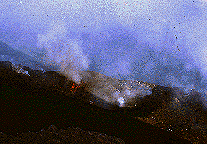 Eruption
from vent 2 in Crater 3 at dawn, 22 August 1994. Broad lava fountains
rise from three closely spaced vents in the center of the soutwestern
depression of Crater 3. This eruption did not reach heights like others
did, in the night before. Note shallowing of the craters.
Eruption
from vent 2 in Crater 3 at dawn, 22 August 1994. Broad lava fountains
rise from three closely spaced vents in the center of the soutwestern
depression of Crater 3. This eruption did not reach heights like others
did, in the night before. Note shallowing of the craters. |
|
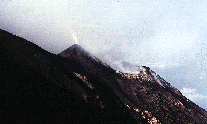 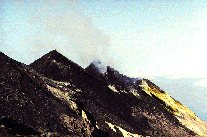 Upper photo: Crater 1 seen from the northeast on the morning of 12 March 1994. The slope below the crater is covered with debris from the October 1993 explosions, and no traces of the May 1993 lava flows are visible. Note absence of cones within the crater. Lower photo: Crater 1 seen from the northeast on the forenoon of 22 August 1994. A spectacular cluster of cones has grown since the last visit, and a small, very recent lava tongue (indicated by an arrow) extends down the N flank below the lowest point of the crater rim. New dark tephra covers the areas around the crater. Get comparison view of this and previous image here. Still more detail of the lava flow is visible here. |
|
|
|
If the activity from all these points had already been impressive, the most powerful, and still more impressive, eruptions came from a complex feature in vent area 3/2. During the ascent, a few of its eruptions had already been visible but it had not been clear where they originated. We had to stay about 30 minutes on Pizzo sopra la Fossa to see the first of these bursts directly. Until then, the vent area had shown bright incandescence, and we were aware that there was still another active place. It formed an irregular depression in the otherwise very high floor of Crater 1.
Eruptions from this vent, or vent complex, did not make as much noise as those from the other vents (very much like during all of my previous visits), but it made enormous fountains. Sometimes, only one vent erupted, ejecting fountains more than 150 m high. In most cases, there were three connected vents lying close to each other (in an area about 30 m wide) that erupted simultaneously, forming very broad fountains that rose much higher than Pizzo sopra la Fossa, to maybe 200 m above the vents. Fallout from these fountains covered virtually all of the area where I had stayed during my crater visits in April 1990, August 1991, and March 1994. During one of the largest eruptions, the heat could be distinctly felt on Pizzo sopra la Fossa. On no other occasion had I experienced this before.
Later investigation of comparison photographs of the NE slope of Crater 1 showed that a small lava tongue had issued from the northernmost conelet at vent area 1/1 between the two visits. The upper part of the flow was still steaming on the forenoon of 22 August 1994, indicating that it was very recent, maybe of 21 August - it might have even been erupted during the few hours that we were sleeping in our "casa sullo Stromboli". Unfortunately, we had only arrived during the night so we had not seen the place during daylight the evening before.
Scientists from the University of Udine, University of Stuttgart and Open University of Milton Keynes visited Stromboli between late September and mid-October. The activity during this period was apparently similar to that of 21-22 August, with up to 10 vents erupting and tephra rising as high as 300 m above the vents. Apparently, the largest cone in Crater 1 was no longer erupting in late September but eruptions occurred from two vents on the NE and S sides of the central conelet where I had noted no vents in August (vents 1/4 and, probably, 1/2, on the map in Oct 1994 GVN Bulletin. Note that labeling in this map is different from that used here). Still another vent closer to the SE rim of Crater 1 made oblique ejections. The "Gemelli" did not erupt together anymore. In October, only the westernmost twin erupted, still ejecting gas jets with a few bombs while its neighbor showed only degassing activity. The largest spatter cone in Crater 1 had a continuous gas flare rising 1-2 m above its vent. Eruptions occurred from vents 1/2 and 1/3, depositing pyroclastics outside the crater. Vent 1/4 threw material onto the Sciara del Fuoco.
A cluster of vents were present in late September at location 1 in Crater 3 (named 3/3, 3/4 and 3/5 on the map in GVN Bulletin of Oct 1994), and incandescent magma could be seen in one of the openings; however, there were no eruptions. Powerful eruptions still occurred from vent area 2 in Crater 3, being stronger than those from Crater 1. There were two or three vents erupting successively from this site on 5 October, including a smaller vent first observed on 1 October. The amount of ash in the emissions from Crater 3 decreased from 1 until 5 October, but the content of incandescent pyroclastics in the eruptions increased, and eruption frequency increased as well. The fountains now rose 50-300 m high.
From 5 until 8 October, eruptions from Crater 3 again became smaller and more ash-rich. Glow was visible at night above the vents in area 1 of Crater 3.
When visited by a student of Kiel University, Pietro Constantino, in mid-October 1994, frequent eruptions occurred from the largest vent at 1/1, immediately adjacent to the central cone that itself showe a glowing summit vent but did not erupt. Apparently, this was the only erupting vent within Crater 1 during Pietro's brief visit. At 3/1, there were two glowing vents that did not erupt. Most eruptions occurred from 3/2 which had notably subsided and had at least two eruptive boccas, one in its southeastern part and another to the southwest. Both erupted simultaneously, the latter producing more vigorous fountains that rose to about 150 m above the crater. The subsidence of 3/2 is the only morphologic change evident in Pietro's night photographs.
The vigorous activity initiated sometime during June or July 1994 ended during November (as several persons living on the island told us), and "normal" Strombolian activity continued through the end of February 1995.
- The following is summarized
in the
April 1995 issue of the GVN Bulletin; this is a slightly extended
version.
A powerful explosion occurred at 1740 on 5 March 1995 (see the seismicity graph of the Stromboli Project at Università di Udine). A tephra column was observed from the village of Stromboli. Visitors on the summit reported lapilli falling on Pizzo sopra la Fossa but thought that "this was normal" (until they learned that this was by no means the case). No one was injured this time.
The explosion blasted a new pit out of the northeastern part of Crater 1, also taking part of the most conspicuous August 1994 cone with it (the one seen in eruption on the top of this page and on the Stromboli home page). The lower and broader northern August 1994 cone (1/1) was also largely destroyed during this event.
Stromboli residents reported that during the remainder of March and thorugh early April, explosions could sometimes be heard in the village of Stromboli, indicating that there was a new phase of somewhat stronger activity. By mid-April, though, conditions had again changed. The day before Giada and I arrived at the island, the mayor of the town of Lipari (to which Stromboli belongs politically) officially declared a state of alarm and restriction of access of the volcano. As was told in the news that evening, there were fears of a larger eruption, lava flows, and possible "seaquakes" (tsunami? The word "maremoto", seaquake, is often used in Italy but is highly misleading since it is the earth , or its crust, below the sea that moves!). The reason for these fears was the unusually low level of eruptive and seismic activity, the news reports said.
When arriving at Stromboli on the late forenoon of 19 April, local rumours were highly contradictory. Some had it that the whole alarm thing had been some kind of error and that a failure had occurred at one of the seismic stations. However, when we made the ascent on the evening of the same day, we encountered a barrier that had been placed across the main path leading uphill, close to the "Osservatorio" pizzeria at Punta Labronzo. Numerous tourists had already built a new path bypassing the barrier. We were astounded when finding that a smaller track parallel to the main one had not been blocked at all.
The activity was unusually low indeed. Only when approaching the upper section of the ascent, we noticed that there were some eruptions. They all came from Crater 3, however, while Crater 1 did not show any activity. Due to the darkness and a gas plume, the changes at the craters were not yet visible. We arrived at Pizzo sopra la Fossa shortly after midnight on 20 April and immediately began with continuous observations.
Sizeable eruptions occurred only from vent area 3/2 at invervals ranging from 2 minutes to more than one hour. It appeared that only one bocca in the center of the vent area was active; due to subsidence of the crater floor, the vent itself was not visible. Fountains were considerably lower than in August 1994, rising less than 100 m above the crater. All material fell back into the vent and onto the northwestern crater rim. Vent area 3/1 had returned to spattering from an active lava pond at depth, extremely similar to the activity I had observed in detail in March 1994. Occasionally, there were larger ejections of large clots of fluid lava from the pond, but all fell back into the pit except in two cases when spatter fell on the outer NE side of the pit. The usual whooshing noises were audible from that site, accompanied again by the somewhat goofy "pif-paf" noises heard 13 months earlier.
At long intervals, very small gas puffs occurred from a small bocca in the central part of Crater 1. They were accompanied by brief "thudding" noises and solely ejected burning gas to less than 10 m height. People we had encountered while climbing to the summit had told us that one notable eruption had occurred from this vent; there were no real eruptions (of solid material) while we were on the summit, neither during the night nor during the day.
By daybreak, features of the crater area became more clearly visible, and after 0900, vapor and gas emission notably decreased (due to decreasing humidity), allowing a perfect panoramic view (FIgures 5-11 and 5-12). Some significant changes had occurred since August 1994, the most notable being the formation of the explosion pit of 5 March 1995 in Crater 1, and the subsidence of the active areas within Crater 3. The central cone of vent area 1/2 which had been so vigorously active eight months earlier presented a spectacular aspect, its interior exposed neatly to observers on the Pizzo sopra la Fossa. Some stratification and its now-inactive conduit were plainly visible (Figure 5-12). The "Gemelli" cones had remained intact and appeared larger than in August 1994. No trace was visible of the lower but broader cones in vent area 1/1; these features had been completely obliterated by the March explosion.
As usually during the hours after sunrise, most of the eruptions were accompanied by the emission of ash plumes, all from vent area 3/2. We observed a striking increase in the frequency of these eruptions after 0800 when, during a 25 minutes period, there were six eruptions. From 0910 until 1210, the same vent produced only five more eruptions.
The only signs of activity within Crater 1 came from a small bocca on the near base of what was left of the central August 1994 cone, consisting of very small and brief gas explosions. Occasionally, dark fumes rose from these explosions, but there were no ejections of clastic material. Crater 1 was ominously silent, and this was probably one reason for the state of alarm.
Staying on the summit until mid-afternoon, we had the chance to extensively photograph the craters and explore the Vancori region where we had not been before. We did not approach the craters but saw a person who did it. He said later that everything down there had been so quiet that, for the first time in all his Stromboli experiences, he had been able to get to the far (Sciara) side of Crater 1. The same man had been at the craters during the intense activity of July-August 1994 (!).
On our way back to the civilized world, we had a spectacular profile view of the half-destroyed central cone in Crater 1 (Figure 5-13), rising vertically above the pit created by the 5 March 1995 explosion - a symbol of the rapid changes that have occurred at Stromboli during the past two years.
We observed Stromboli for a couple of hours on the evening of 21 April from Punta Labronzo. Compared to the day before, no changes were evident. About twice per hour, lava fountains with ash plumes rose from vent area 3/2. The ash plumes were slowly driven down the Sciara del Fuoco by a strong wind until arriving at sea level, a phenomenon not witnessed by us earlier. A weak, fluctuating glow in the central part of the crater area indicated continuing lava pond activity at 3/1.
Two days later, we were back on the same site, and conditions had significantly changed. A much stronger, though still fluctuating, glow was present above 3/1, and eruptions from 3/2 were the same as before. However, a new brightly glowing spot had appeared on the northern rim of Crater 1. Soon after our arrival at Punta Labronzo, a spectacular ash-free lava fountain shot up from that site to at least 150 m; it was narrow and obliquely directed to the northwest, right towards the upper Sciara del Fuoco. While a cannon-shot like bang arrived at our vantage point, abundant spatter and bombs fell onto the Sciara and cascaded down to about half its extension. For several minutes afterwards, innumerable glowing spots moved, rolled and jumped down the scree, accompanied by crackling and clattering noises. Stromboli thus manifested its return to more normal conditions; during our observation period there were four more of these eruptions, each strikingly resembling the previous, at intervals of 10-25 minutes.
In fact, from what we saw during those April days, we did not quite get the impression that something abnormal was at hand. True enough, the volcano was quieter than I had ever seen it before. However, from what I knew about Stromboli's eruptive behavior during recorded history, a period of quiet did not necessarily imply that the volcano was preparing for a major eruption. All larger or paroxysmal eruptions occurred quite randomly, some after a period of reduced activity, others after a period of increased activity, and by far the largest part was preceded by absolutely "normal" conditions. The reasons for the declaration of alarm to me were highly unclear, and have remained so until now. Indeed, the access restrictions have been somewhat modified (see latest news) since. The risk meanwhile has remained essentially the same, and it will be so once no one will talk any longer about an alarm. Stromboli is ALWAYS capable of doing bad things, and it is to be hoped that this will not have tragic consequences one day.
We got back to Stromboli on 28 September 1995. This visit was not too successful, regarding observations and photography. It did however, allow some general statements about the activity and vent conditions. This is our "official" report to the GVN Bulletin, not reflecting much our personal feelings.
Visit to Stromboli, 28-29 September 1995
Basically, the situation of Stromboli had not changed significantly since the April 1995 visit. The most notable developments were the further collapse and destruction of the central 1994 cone within Crater 1 and the formation of a new incandescent bocca on the SE base of the southern "twin" cone, vent area 3. This bocca made no solid ejections but was the site of occasional gas explosions.
The size of the eruptions was lower than normal on 28-29 September 1995 but generally normal during September 1995. There were eruptions from up to four vents (1 and 2 within Crater 3 and probably two vents in the northern part of Crater 1), producing beautiful lava fountains. The fountains from the northernmost vent in Crater 1 projected material onto the upper part of Sciara del Fuoco.
Stromboli ended the decade 1985-1995 in a relatively unspectacular manner - if this can be said so, given that Stromboli is spectacular even during a low level of activity. There were no indications of major changes in its activity within the foreseeable future. But is there anything foreseeable at this volcano? All of the major events described on these Stromboli-related pages have not been preceded by anything particular. The events during the years since 1995 has confirmed this - the volcano produced more "larger-than-normal" explosions in 1996 and 1998-1999 than in previous years.
Copyright © Boris Behncke, "Italy's Volcanoes: The Cradle of Volcanology"
